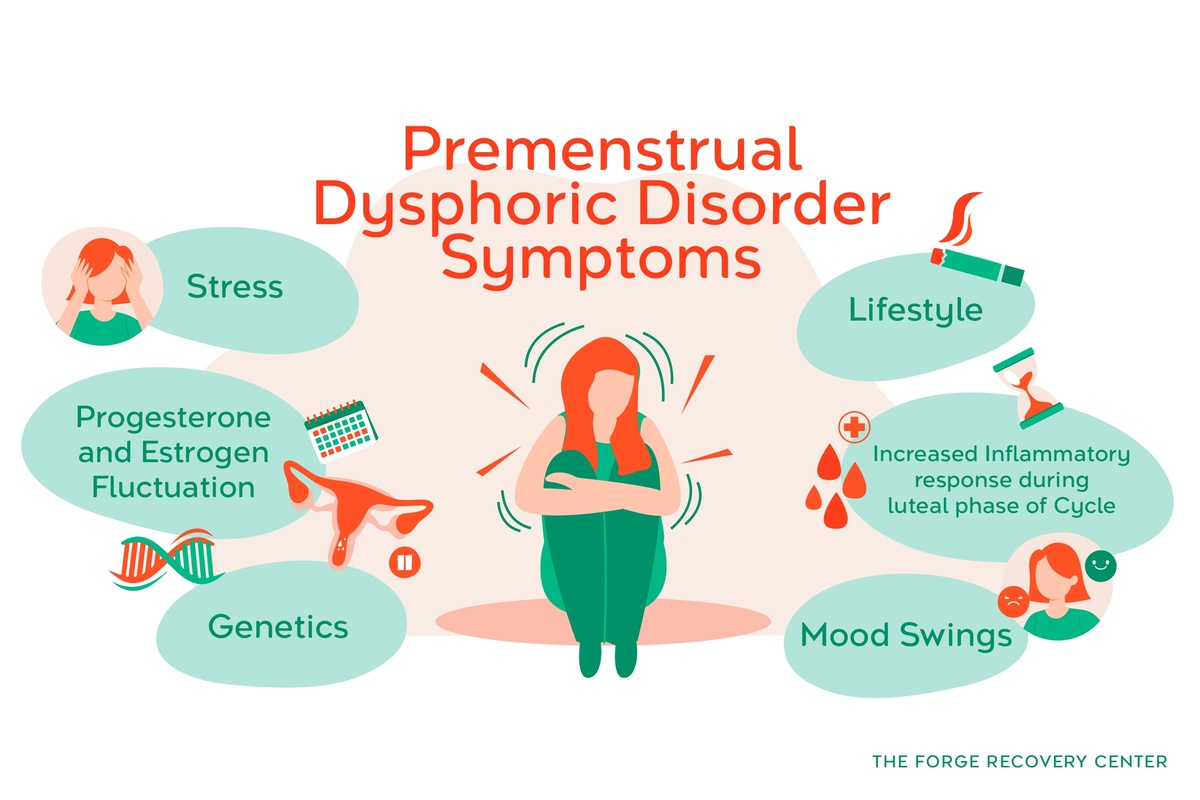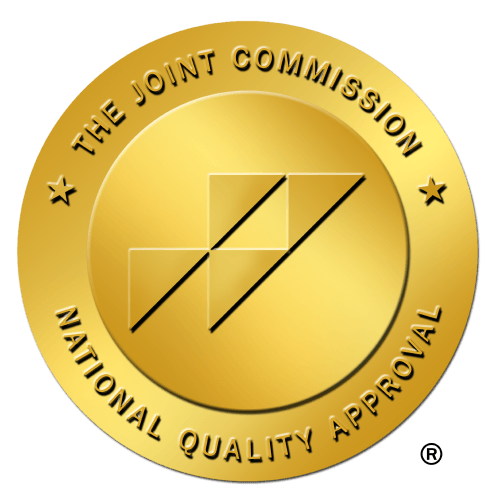Premenstrual Dysphoric Disorder: Symptoms, Causes, & How It's Treated


Premenstrual dysphoric disorder (PMDD), a more severe form of premenstrual syndrome (PMS), can significantly impact your daily life. It manifests as physical symptoms like bloating, headaches, and breast tenderness, but also brings extreme irritability, anxiety, and depression. Fortunately, treatment is available, typically in the form of therapy and medication. Learn more about symptoms and treatment options for PMDD, and call The Forge Recovery Center if you or a loved one are in need of professional support.
What Is Premenstrual Dysphoric Disorder?
Classed as a mood disorder, premenstrual dysphoric disorder (PMDD) is a severe form of premenstrual syndrome (PMS) that affects a small percentage of women during their menstrual cycle. It is characterized by intense mood swings, irritability, anxiety, depression, and physical symptoms that can significantly interfere with daily life. Women with PMDD may also experience extreme emotional sensitivity, difficulty concentrating, fatigue, and changes in appetite.
The exact cause of PMDD is not known, but hormonal changes, genetics, and brain chemistry are believed to play a role. Treatment options may include lifestyle changes, medication, therapy, and hormonal interventions.
PMDD Vs. PMS
Premenstrual dysphoric disorder is a severe form of premenstrual syndrome (PMS) that can significantly impact a person's quality of life. The core difference between PMDD and PMS lies in the intensity and severity of symptoms. While PMS may cause mild discomfort and mood swings, PMDD symptoms are more extreme and can include severe depression, anxiety, irritability, and even suicidal thoughts.
Additionally, PMDD symptoms typically interfere with daily activities and relationships, making it crucial to seek proper diagnosis and treatment.

Premenstrual Dysphoric Disorder Symptoms
Premenstrual dysphoric disorder carries a set of emotional and physical symptoms that mirror PMS, including:
Emotional Signs
When experiencing premenstrual dysphoric disorder (PMDD), you may notice intense emotional changes. Mood swings, irritability, anxiety, and depression are common during this time. You might also feel overwhelmed by feelings of sadness, or hopelessness. These emotions can significantly impact your daily life and relationships.
It's essential to recognize these emotional signs as part of PMDD and seek support from healthcare professionals. Engaging in activities that promote relaxation and stress relief can help manage these symptoms effectively.
Physical Symptoms
Alongside emotional challenges, PMDD can manifest in various physical symptoms. You may experience bloating, breast tenderness, and headaches before the onset of your menstrual period. Fatigue, muscle aches, and joint pain can also occur due to hormonal fluctuations during the luteal phase.
Moreover, some individuals with PMDD report digestive issues such as constipation or diarrhea. These physical symptoms can be distressing but understanding that they are linked to hormonal changes in the menstrual cycle can provide reassurance. Seeking medical advice for symptom management is crucial for improving your quality of life.

Are You Struggling with Mental Health or Addiction?
We Can Help. Call Us Now!
CALL: 877-839-1772
Premenstrual Dysphoric Disorder Treatment Options
Treatment for PMDD typically involves a combination of therapy and medication, such as SSRIs, to manage symptoms. Lifestyle changes like maintaining a healthy diet and exercising regularly can also contribute to your mood and combat PMDD symptoms. Here’s a more in-depth summary of how PMDD is treated:
Therapy
When dealing with premenstrual dysphoric disorder (PMDD), therapy can be an effective treatment option. Cognitive-behavioral therapy (CBT) is commonly used to help you manage your emotions and thoughts during PMDD. This therapy focuses on changing negative thought patterns and behaviors that may worsen your symptoms.
Therapy sessions usually involve identifying triggers that exacerbate your PMDD symptoms. By recognizing these triggers, you can develop coping strategies to handle them better. Therapy provides a safe space for you to express your feelings and concerns about PMDD.
Medication
In some cases, medication may be prescribed to alleviate the symptoms of Premenstrual Dysphoric Disorder. Selective serotonin reuptake inhibitors (SSRIs) are commonly recommended as they help regulate serotonin levels in the brain, which can improve mood and reduce anxiety associated with premenstrual dysphoric disorder.
Your healthcare provider may also suggest birth control pills to help regulate hormonal fluctuations that contribute to PMDD symptoms. These medications can help stabilize your mood and reduce physical discomfort during your menstrual cycle.
Lifestyle Changes
Making certain lifestyle changes can also play a significant role in managing Premenstrual Dysphoric Disorder. Regular exercise has been shown to release endorphins, which are natural mood boosters that can help alleviate PMDD symptoms. Ensuring you get enough sleep and practicing relaxation techniques like yoga or meditation can also positively impact your overall well-being.
A balanced diet rich in nutrient-dense foods, such as fruits, vegetables, whole grains, and lean proteins, can support your mental health and reduce the severity of PMDD symptoms. Avoiding caffeine, alcohol, and salty foods close to your menstrual cycle may also help minimize mood swings and bloating associated with premenstrual dysphoric disorder.
Mental Health Treatment Centers
If you find it challenging to manage PMDD on your own, seeking support from mental health treatment centers can be beneficial. These centers offer a range of services tailored to individuals with premenstrual dysphoric disorder, including therapy sessions, medication management, and support groups where you can connect with others facing similar challenges.
Mental health treatment centers provide a supportive environment where you can receive personalized care from experienced professionals trained in treating PMDD. They can work with you to develop a comprehensive treatment plan that addresses your unique needs and helps you effectively manage your symptoms.
How Is Premenstrual Dysphoric Disorder Diagnosed?
Diagnosing premenstrual dysphoric disorder starts with a medical evaluation, and can be monitored through ongoing symptom tracking. Here’s how the diagnosis process works:
Medical Evaluation
When diagnosing premenstrual dysphoric disorder (PMDD), a medical evaluation is crucial. Your healthcare provider will conduct a thorough assessment to rule out other conditions with similar symptoms. They will ask you about your menstrual cycle, mood changes, physical symptoms, and overall health. It's important to provide detailed information to assist in an accurate diagnosis.
During the evaluation, your healthcare provider may perform a physical examination and order various tests. These tests can help identify any underlying medical conditions that could be contributing to your symptoms.
Ongoing Symptom Tracking
Tracking your symptoms over several menstrual cycles is vital in diagnosing premenstrual dysphoric disorder accurately. By keeping a symptom diary, you can record the timing and severity of your mood changes and physical symptoms.
This tracking helps establish a clear pattern of symptoms that align with the diagnostic criteria for PMDD. Your healthcare provider may recommend using specific tools or apps to monitor your symptoms effectively.
In some cases, they might suggest hormonal testing or other assessments to gather more information about your hormone levels and overall health status.

Are You Struggling with Mental Health or Addiction?
We Can Help. Call Us Now!
CALL: 877-839-1772
Causes of PMDD
Premenstrual dysphoric disorder is thought to primarily stem from a family history of PMDD, alongside lifestyle choices and other factors. Here’s a quick overview of the causes:
Genetic Link
When it comes to PMDD, genetics play a significant role. Your genetic makeup can make you more susceptible to developing PMDD. Research suggests that if someone in your family has PMDD, your risk of experiencing it increases.
Lifestyle Choices
Making healthy lifestyle choices can help manage PMDD symptoms effectively. Regular exercise, a balanced diet, and adequate sleep are crucial. You should also avoid alcohol and caffeine, as they can worsen mood swings and anxiety.
Biological Aspects
Biologically, hormonal fluctuations are at the core of premenstrual dysphoric disorder. Changes in serotonin levels in the brain during the menstrual cycle can trigger mood disturbances. This imbalance affects how you feel emotionally and physically each month.
Psychological Factors
Psychological factors such as stress, anxiety, and depression can exacerbate PMDD symptoms. Your mental health plays a vital role in how severe your PMDD symptoms may be. Seeking therapy or counseling can help you cope with these emotional challenges.
Differentiating PMDD & PMS
When differentiating between premenstrual dysphoric disorder and PMS, it's crucial to consider the severity of symptoms. PMDD typically involves more intense and disruptive symptoms compared to PMS. With PMDD, you may experience severe mood swings, extreme irritability, and heightened anxiety that significantly impact your daily functioning. These symptoms usually occur in the week leading up to your period.
On the other hand, with PMS, the symptoms are milder and generally do not interfere as much with your daily life. You might feel bloated, fatigued, or experience mild mood changes but can still carry out your regular activities.
Impact on Daily Life
The impact of premenstrual dysphoric disorder on your daily life can be profound. You may find it challenging to concentrate at work or school due to severe mood disturbances and emotional sensitivity. Physical symptoms like bloating, breast tenderness, and headaches can further hinder your ability to engage fully in your daily activities during this time. In contrast, while PMS can cause some discomfort and minor disruptions in your routine, it typically does not lead to the same level of impairment as PMDD.
Are You Struggling with Mental Health or Addiction?
We Can Help. Call Us Now!
CALL: 877-839-1772
PMDD Vs. Other Mental Health Conditions
When discussing premenstrual dysphoric disorder (PMDD), it's crucial to understand that PMDD is not just a simple mood swing during your menstrual cycle. It is a severe and chronic form of premenstrual syndrome (PMS). Premenstrual dysphoric disorder is categorized under depressive disorders due to its impact on mental health.
Some key symptoms of premenstrual dysphoric disorder include extreme mood swings, irritability, anxiety, and depression. These symptoms can significantly affect your daily life, relationships, and overall well-being. It's essential to differentiate between PMDD and other mood disorders to ensure proper diagnosis and treatment.
PMDD Vs. Bipolar Disorder
While both PMDD and bipolar disorder involve mood changes, they differ in their patterns and triggers. Bipolar disorder is characterized by distinct episodes of mania and depression that can last for days, weeks, or even months. On the other hand, PMDD symptoms occur in a cyclical pattern related to the menstrual cycle.
Understanding the differences between premenstrual dysphoric disorder and bipolar disorder is crucial for accurate diagnosis and treatment planning. While bipolar disorder requires long-term management with medications and therapy, PMDD treatments may focus on symptom relief during specific times of the month.
PMDD Prevalence
To give you an idea of PMDD’s prevalence, we’ve gathered some of the latest data points, along with information about its age disparities and causes:
Premenstrual dysphoric disorder (PMDD) affects approximately 1% of women worldwide, and 5-8% of women of reproductive age in the United States.
PMDD is a severe form of premenstrual syndrome (PMS) characterized by debilitating physical and psychological symptoms that significantly impact daily functioning.
While PMDD is more common in women in their 20s and 30s, it can also affect adolescents and women in perimenopause.
The exact cause of PMDD is not fully understood, but hormonal fluctuations, neurotransmitter imbalances, and genetic factors are believed to play a role.

Are You Struggling with Mental Health or Addiction?
We Can Help. Call Us Now!
CALL: 877-839-1772
Seeking Professional Help
Knowing when and where to seek help starts with recognizing the need, and then reaching out to the right professionals. If you’re ready to start therapy, you can contact a mental health professional such as a therapist or psychiatrist, or opt for a mental health treatment center for comprehensive care. Here are the steps:
Recognizing the Need
When you find that your daily life is significantly disrupted by intense mood swings, irritability, and anxiety every month, you may need to consider seeking professional help for premenstrual dysphoric disorder (PMDD). If these symptoms interfere with your work, relationships, or overall well-being, it's crucial to recognize that they go beyond typical PMS.
To determine if what you are experiencing is PMDD, pay attention to the timing of your symptoms. They typically occur in the week before your period and improve within a few days after it starts. Keeping a symptom journal can help track patterns and provide valuable information for healthcare professionals when seeking a diagnosis.
Finding Support
When it comes to finding support for PMDD, reaching out to mental health professionals is essential. You can start by scheduling an appointment with a psychiatrist or psychologist who specializes in mood disorders. These professionals have the expertise to assess your symptoms accurately and recommend appropriate treatment options.
Mental Health Professionals
Psychiatrists: Specialize in diagnosing and treating mental health conditions using medication management and therapy.
Psychologists: Focus on providing therapy and counseling services to address emotional and psychological issues associated with PMDD.
Mental Health Treatment Centers
If you require intensive treatment or support for managing PMDD, considering mental health treatment centers can be beneficial. These facilities offer specialized programs tailored to individuals dealing with severe mood disorders like PMDD. By enrolling in a treatment center, you can access comprehensive care from a team of experts dedicated to improving your mental health.
Closing Thoughts
After learning about premenstrual dysphoric disorder (PMDD), its symptoms, treatment options, diagnosis methods, causes, and distinctions from other conditions, you are now equipped with valuable knowledge to navigate this challenging condition. Remember that seeking professional help is crucial in managing PMDD effectively. By consulting with healthcare providers, you can explore personalized treatment plans tailored to your specific needs. Don't hesitate to reach out for support when needed.
Understanding PMDD empowers you to take control of your health and well-being. By staying informed and proactive, you can work towards alleviating symptoms and improving your quality of life. Remember that you are not alone in this journey, and there are resources available to assist you along the way.
Treatment for Premenstrual Dysphoric Disorder in Orange County
The depressive symptoms and mood fluctuations of premenstrual dysphoric disorder (PMDD), a more severe form of premenstrual syndrome (PMS), can significantly impact daily life. The emotional and physical symptoms strike in a week or two before your period, causing extreme irritability, anxiety, depression, and even suicidal thoughts that can disrupt relationships, work, and overall well-being. But you’re not alone, and treatment is available to help you reach a place of mental stability.
At The Forge Recovery Center, our team of mental health experts is ready to support you on your healing journey. We also offer a number of therapies to guide you along the way. Explore them below, and call us today if you or a loved one are seeking professional support.
Treatment Modalities We Offer
At The Forge Recovery Center, we provide a variety of evidence-based treatment approaches to support your healing journey:
Case Management
Our experts guide clients toward resources that support recovery, assessing personal risks to create a comprehensive treatment plan.
CBT
Cognitive-behavioral therapy (CBT) helps clients modify negative thought patterns and behaviors associated with drug addiction, aiming to prevent relapse and foster a drug-free lifestyle.
DBT
Dialectical behavioral therapy (DBT) helps individuals deal with emotional instability that arises due to substance abuse, promoting emotional regulation and positive life changes.
EMDR
Eye movement desensitization and reprocessing (EMDR) allows clients to process trauma that may impact their addiction by using eye movement techniques, which may reduce psychological distress.
Experiential Therapy
Experiential therapy aims to rekindle life’s joys and confront the underlying trauma of addictive behaviors through engaging, hands-on, and therapeutic activities.
Family Counseling
Family therapy works to strengthen bonds and nurture a supportive network, which is crucial for sustained recovery and abstinence.
Group Therapy
Group therapy sessions offer a comfortable space for support, complementing the recovery process through shared experiences.
Individual Therapy
One-on-one sessions address the unique challenges faced by each client, supporting their journey toward a substance-free life.
MAT
Medication-assisted treatment (MAT) combines approved medications with counseling to combat addiction, helping to ease withdrawal symptoms and reduce relapse risk.
TMS
Transcranial magnetic stimulation (TMS) is a non-invasive technique that uses magnetic fields to stimulate the brain, potentially reducing intense drug cravings.
Motivational Interviewing
Motivational interviewing empowers clients to make healthier decisions, such as overcoming cocaine addiction, by building self-efficacy.
Trauma-Informed Care
In understanding trauma’s impact on addiction, trauma-informed care guides clients through treatment while addressing its effects on mental and emotional well-being.



